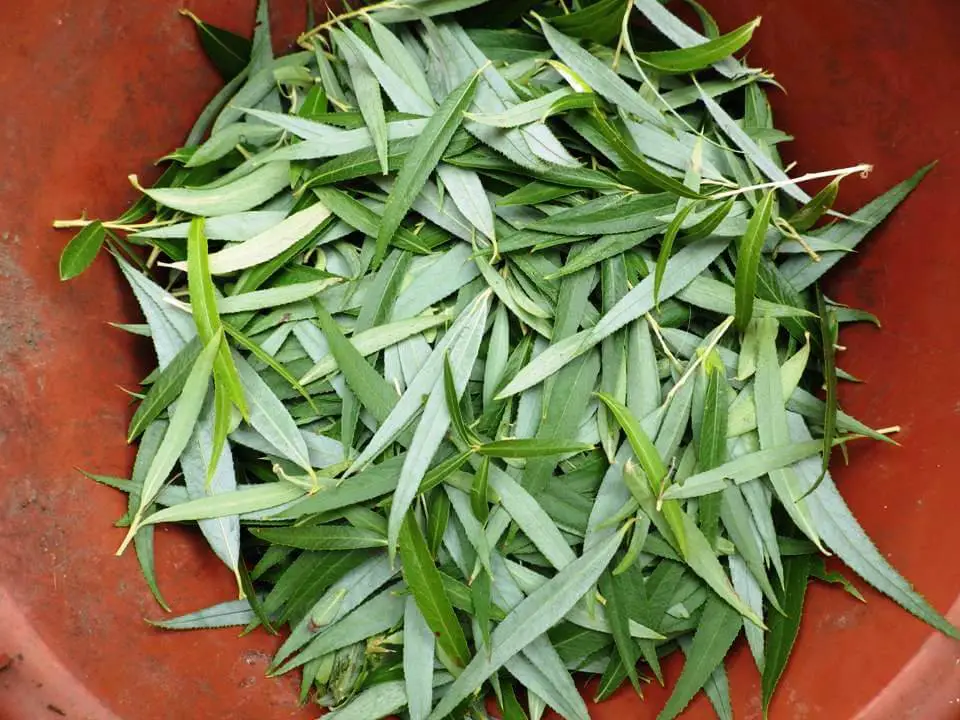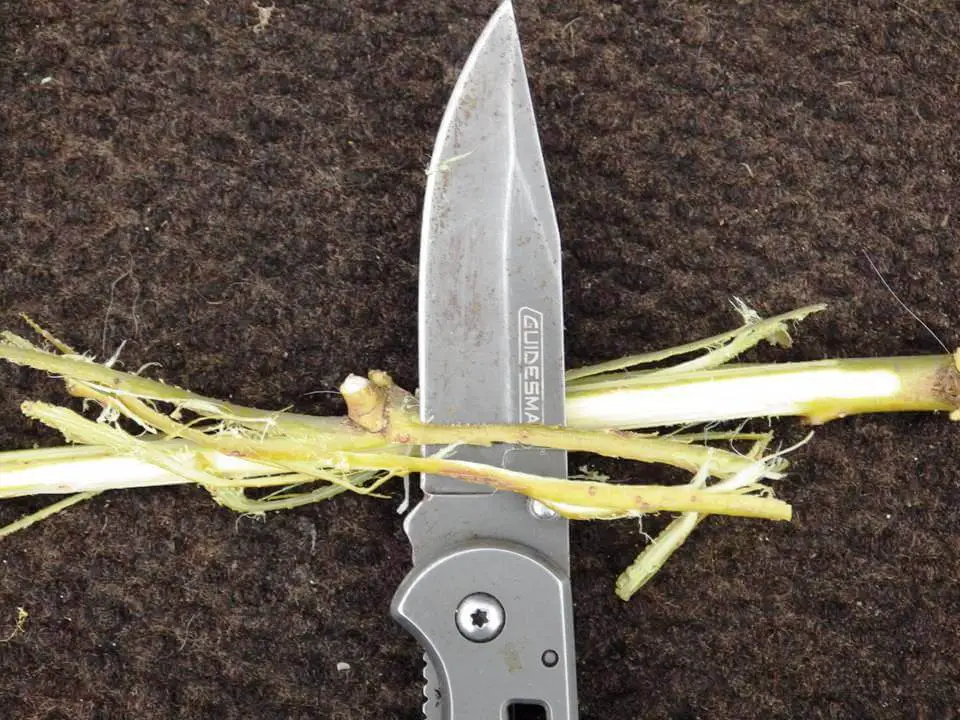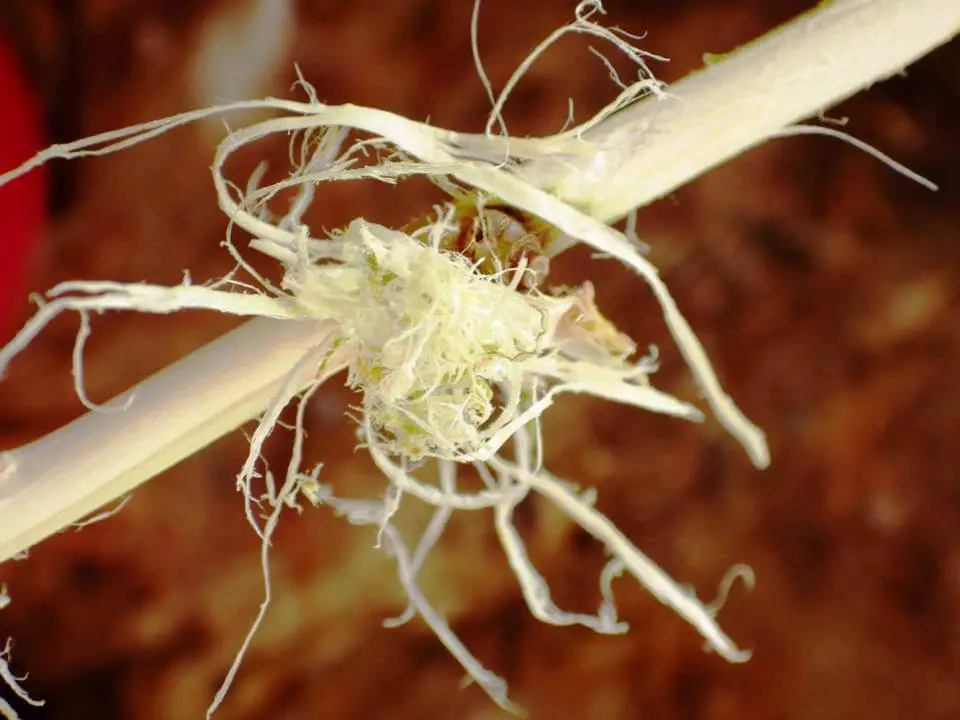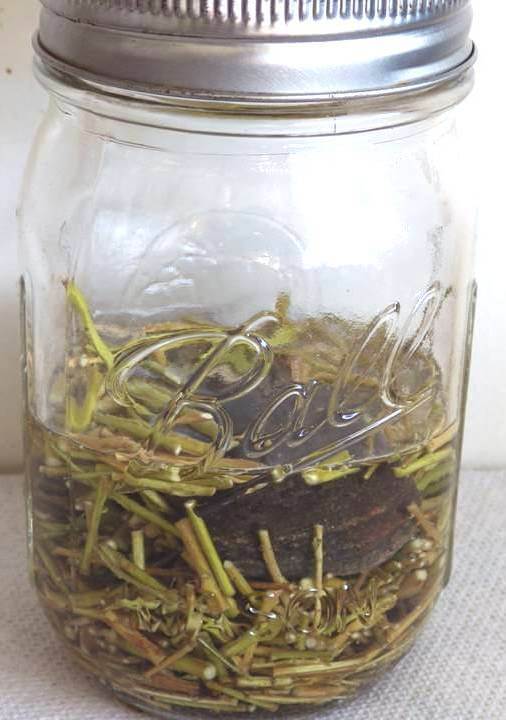Estimated reading time: 22 minutes
Of all of the herbal remedies that have been touted over the years, aspirin from willow bark may be the oldest and most reliable. It’s also the easiest, although there are variations that require a bit of time.
One of the reasons aspirin from willow bark is so dependable is due to the fact that aspirin itself is made from willow bark. Why? Because willow bark contains a compound known as salicin, which is the active ingredient in everyday aspirin. Extracting the salicin into a tea, tincture, or even chewing the raw bark can relieve both pain and inflammation.
Want to save this post for later? Click Here to Pin It On Pinterest!
A Bit of History
Records of ancient people using willow bark for pain relief go back 3,500 years. The first written record was found in an ancient Egyptian papyrus call the “Ebers Papyrus” and used the leaves and bark of the white willow to treat wounds.
The Sumerians also left records of using the bark from willow trees as a painkiller and antipyretic (a drug used to lower or prevent fever). Not to be outdone, Socrates himself recommended chewing on willow bark to reduce fever and inflammation.
Willow bark pain treatment is a standard part of ancient Chinese medicine and countries across Europe have used it for centuries. And the Roman physician Celsius recommended willow leaves to treat inflammation, pain and swelling.

And a Bit of Science
The salicin in willow trees falls within the category of salicylates. Salicin is derived from Salix alba vulgaris, the Latin name for willow trees. It was a small group of scientists starting with Edward Stone in 1763 in England who first distilled salicin to acetylsalicylic acid and created the first form of aspirin. It worked.
Willow bark moved from obscure laboratories to the mainstream in1853 when a German chemist by the name of Charles Frederic Gerhardt synthesized acetylsalicylic acid for the first time. He worked for a German Pharmaceutical company named Bayer and they decided to call their new wonder drug aspirin.
For the record, aspirin falls in the category of NSAID’s. That stands for Non-Steroidal Anti-Inflammatory Drug. Other pain relievers identified as NSAID include ibuprofen (Advil) and acetaminophen (Tylenol).
Possible Treatments
Unlike other herbal supplements and cures, there have been highly credible clinical studies done on herbal pain relief derived from willow bark, although the studies were mostly focused on lower back pain, fever, and inflammation.
Here are highlights of many of the conditions that willow bark can treat based on either clinical studies or a long history of usage:
Headache
Willow bark has not only been shown to relieve headaches but there is some evidence that is causes less gastrointestinal distress that other NSAID pain relievers can lead to. Then again, people prone to stomach upset should probably avoid the use of willow bark and its extracts in addition to traditional over the counter NSAID’s.
Lower Back Pain
This seems to be the home run for willow bark as clinical studies continue to verify its effectiveness for muscle strain and aching in the lower back.
Osteoarthritis
Several studies have shown that willow bark is effective at treating pain due to osteoarthritis particularly in the neck and lower back. Another study showed significant pain relief of osteoarthritis in the knee and hip.
Other Conditions
Studies are ongoing but there have been small studies and anecdotal evidence from a long history of usage for the treatment of:
- Fever
- Menstrual Cramps
- Flu
- Tendonitis
- Bursitis
About Willows

To date more than 300 species of willow have been identified. Most are trees but some are shrubs. All of them contain salicin to varying degrees but the white willow (salix alba), the black willow also known as the pussy willow (salix negra), and weeping willow (salix babylonica) tend to present the highest concentrations of salicin.
In many commercially manufactured herbal pain relievers derived from willow bark, all three of the willow trees mentioned are used to make the remedy. That’s not necessary, and one willow source works, but combining willow varieties may yield a higher percentage of salicin.
The white willow is most often used as a source for pain relief due to its size and range. In fact, white willows are found in every country on Earth except Antarctica and Australia. In a pinch, any willow will present some level of natural salicin in its bark and leaves, but higher concentrations are found in the white, black and weeping willow.
Willow Tree Identification
Willow trees are short-lived trees maturing and dying in about 30 to 40 years. They reach heights up to 50 feet on average. They tend to grow in wet, swampy areas and along the banks of rivers, ponds and lakes.
Willow leaves have a unique pointed shape with points forming on both ends of the leaf. The leaves are narrow and vary in length.

Most willow leaves have a small saw-tooth edge and the underside of the leaf is usually lighter in color.
The leaves grow in long rows on thin branches, some of which droop down like you would see on a weeping willow.
The bark of smaller branches is smooth while the bark on the trunk can develop deep furrows and a thick outer bark.
Harvesting the Bark
The best time to harvest willow bark is in the spring. That’s when the sap is running and the salicin concentrations are higher. As the season moves into July and on into summer and fall, the concentrations of salicin falls off. This can affect total dosage levels and we’ll cover more about that later.

One solution is to harvest lots of willow bark in the spring and dry the bark and store it. Over time the salicin will degrade but if packaged and stored properly it should get you through the winter. You could also make an extract and store it the same way.
The best bark to harvest is from the smaller branches.

The bark on the trunk can be very thick and harvesting the bark from the trunk can damage and even kill the tree.
The smaller branches are easy to reach and the bark usually peels easily. What’s important to know is that you’re looking to use the soft, inner bark—not the hard outer bark—when making your willow bark tea, extract, tincture, or most any other treatment using willow bark. This soft inner bark is referred to as the cambium and xylem layers and are the circulatory system for any tree. That’s where the salicin is concentrated.
The easiest approach is to cut various branches from the trees. Approach it the way you approach pruning a tree and cut off the suckers emerging from the base of the trunk; a sampling of branches from one of the limbs, or any branches approaching the ground. If you take a pruning approach to harvesting the willow bark, you can actually help the tree rather than hurting it.
Preparing the Bark
There are varying steps for preparing the bark depending on how you plan to turn it into medicine. As we mentioned, the medicinal options include teas, tinctures, extracts and powder as pills in caplets. Here are the basics:
1. Prune Some Branches
The first step is to cut and collect some branches from your willow tree. How many you prune depends on how much willow bark you plan to use but a few dozen branches should get you off to a good start.

2. Strip the Leaves
You need to strip the leaves from the branches. You can do this by holding your fingers tightly on the branch and stripping them down. You can also save the leaves to process or grind later into a pulp for a poultice or herbal bandage for topical treatments of bruises and other injuries.

3. Sort the Branches
Sort your branches into 3 piles isolating the thin, smaller branches the thicker branches measuring about ¼ inch and finally the thicker branches up to ½ inch thick. The very thin branches can be ground up or mashed for drying with no further work. The ¼ inch and ½ inch branches need to be stripped of their outer bark.

4. Strip the Bark
There are a couple of ways to do this. In early spring you may be able to peel the bark directly off the branch in long strips. As the season progresses into later spring and summer, you may need to use the edge of a knife to scrape off the bark.
Remember to make sure you harvest the thin film of inner bark for your willow bark medicine.

You can strip away this thin “cambium and xylem” layer using your knife again to rub along the inner heartwood after peeling to scrape it off.


Collect your strips of cambium. You can chew it raw if you are in a survival situation but be prepared for a bitter burst as you chew. Swallow the saliva and spit out the remaining bark the way you would spit a chaw of tobacco. You’ll probably need a drink of water to relieve the bitter taste in your mouth.

NOTE: You can also chop and crush the very small branches (1/8 inch thick or less) rather than trying to strip them.
Cut them into 1-inch piece and pulse in a food processor until chopped up, or smash with a mortar and pestle, or in a survival situation, crush them between two rocks. They can then be used as is to make a tea, extract, or dried in the next step. The small bits of heartwood and outer bark won’t affect the salicin levels extracted or steeped.

5. Dry the Bark
Processing the bark into various forms starts with drying the strips of bark. There are a few ways to do this.
A food dehydrator works and the thin bark strips will dry quickly. Put it on a medium setting and check it often until it is dry and brittle.

You could also dry your bark in the sun. Put it on a plate and place it in the sun out of the wind.
Check it from time to time and maybe turn it over once or twice until it is dry and brittle. Just remember that as it dries it will become susceptible to blowing away in the slightest breeze so drying it in the sun indoors may be a wise move.

You want the bark as dry as possible for storage and especially if you plan to pulverize it into a powder and scoop it into capsules.
The Dosage Dilemma
A common challenge with any foraged herbal remedy is determining the proper dosage when making your herbal treatments. Commercially prepared herbal remedies have general dosages and instructions usually printed on the package, but when you’re making your own you’re on your own.
A lot of factors affect dosage with willow bark. One is the time of year with the highest concentrations of salicin present in the spring and lower as the season goes on. Another factor is the species. Some willows like white willow have more salicin than others.
Preparation methods can also cause variations with alcohol-based extracts typically distilling the most salicin while water-based teas may extract less. Finally, weather conditions and other environmental factors can affect salicin levels in all species of willow.
The result is you just can’t accurately gauge salicin percentages and levels when making it yourself. We’ll recommend general quantities and dosages as we go through each preparation, but there may be a little trial and error as you go.
The common sense approach is to try a little and see how you feel. Take more as needed until you feel some improvement or notice any side-effect like stomach upset.
Over time you’ll understand not only how to manage dosage but how to adjust it for your own use and family use. A little later we’ll cover some side-effects and cautions and one of them is that children under the age of 16 should not use willow bark for pain treatment except in a survival emergency.
Making Medicine from Willow Bark
As we mentioned, there are a few ways to do this. Listed below are some of the traditional treatments and uses for willow bark that have been developed over the centuries.
Willow Bark Tea
The fastest and easiest way to use willow bark for pain treatment is to make a tea. The dried bark is cut into small chips for making the tea but in a survival situation the raw strips of cambium can be steeped in hot water as well. It will always have a bitter taste. A little honey, maple syrup or even sugar can help.

Here’s the recipe for willow bark tea (makes one cup of willow bark tea).
Ingredients:
- 2 tablespoon of dried willow bark chips
- 16 ounces of boiling water
Directions:
- Bring the water to a boil and add the 2 tablespoons of willow bark chips.
- Boil the chips for 10 minutes.
- Remove from heat and let steep for 30 minutes on the pot.
- Strain the tea through a coffee filter, rag or cheesecloth to remove the bark chips.

- Add a sweetener if you like and drink the tea. The 16 ounces of water will boil down to about 8 ounces or one cup during the process.
DOSAGE: After drinking one cup, assess the effects and consider another cup of tea if needed. Don’t exceed more than 4 cups a day and assess any side-effects you may notice.
Willow Bark Tincture (using alcohol)
This is a concentrated form of willow bark aspirin as an extract using alcohol (vodka) to strip away the salicin from the bark. We’ll cover an alternative way to do this using apple cider vinegar if you don’t want to use vodka, although alcohol is a standard ingredient in many other extracts.
The extract can be added to water or a fruit juice because the concentrated extract is extremely bitter. If you’ve ever let an aspirin dissolve in your mouth, you’re familiar with this definition of bitterness.
Extracts take time (3 months), so if you’re looking for immediate relief, you may want to consider the tea or other uses we’re about to cover. The good news is that the alcohol helps preserve the effectiveness of the salicin over time. Here’s the recipe.
Ingredients:
- 2/3 cup of dried willow bark chips (or 2/3 cup of chopped bits of small, thin willow bark branches 1/8-inch or less).
- Enough vodka to cover the chips or chopped branches. (Don’t use rubbing alcohol or any other type of alcohol that cannot be safely consumed).
Directions:
- In a 16-ounce mason jar with a lid, add the chips or chopped branches.

- Pour the vodka over the chips or chopped branches and tighten the lid.

- Shake the jar vigorously and store in a cool dark place for 3 months.
- Shake the jar from time to time while stored.
- After 3 months strain the extract through a coffee filter or piece of cheese cloth.
- Store in an amber dropper bottle. The extract is concentrated and you’ll only be using a few drops at a time.
DOSAGE: 2,000 mgs is the standard recommendation. Start with 4 drops of your homemade cider vinegar extract and assess results and side-effects if any.
Willow Bark Extract (using apple cider vinegar)

The acetic acid in apple cider vinegar serves the same function as alcohol when making an extract, so it's a great alternative if you'd rather not use alcohol. Plus, apple cider vinegar has probiotic properties.
However, apple cider vinegar is not as effective at removing salicin as alcohol, so don’t use dried strips of bark.
Use fresh bark and shaved inner xylem instead.

One common recommendation with this method is to add honey to offset the astringent bitterness that result from a combination of vinegar and willow bark.
The process is the same as an extract made from alcohol except you add a tablespoon of honey to filtered extract before storing in amber dropper bottles.
DOSAGE: 2,000 mgs is the standard recommendation. Start with 4 drops of your homemade cider vinegar extract and assess results and side-effects if any.
Willow Bark Capsules

You can grind your dried willow bark into a powder and scoop it into capsules to mimic the way you take aspirin from a bottle. Here’s the recipe.
Ingredients:
- 2 dozen empty pill capsules
- ¼ powdered willow bark
Directions:
- Grind the dry willow bark using a food processor, coffee mill or mortar and pestle. Try to get a fine powder as much as possible.
- Use the empty capsules to scoop up the powder and push the two ends of the capsules together.
- Store in a pill bottle in a cool, dark place.
DOSAGE: Take one capsule with water and assess results after one hour. Do not take more than 4 capsules a day.
Chewing Willow Bark (the field dose)
In a pure survival mode you can strip off a piece or two of willow bark and just chew it to relieve pain. It will be very bitter and an occasional swig of water will help. The key is to grab a few branches and chew as you go until you feel some relief.
About Those Leaves

Willow leaves are an inevitable by-product of willow bark harvesting and based on past history can also be used as a topical treatment for injuries. You can use either fresh green leaves or dried leaves if you want to store them for later use.
The typical application is with a poultice made from either cheesecloth or thin fabric. The poultice is applied to the skin and taped in place over a bruise or other injury to provide topical pain relief. It can also be used to treat sunburn or other minor burns of the first-degree and even the blisters from a second degree burn.
They should not be used with third degree burns where cracks in the skin could allow any bacteria from the leaves to enter the bloodstream. Even then, we recommend soaking and rinsing the leaves in vinegar as a first step.
Ingredients:
- 4 cups of fresh or dried willow leaves
- Vinegar
Directions:
- Place the willow leaves in a bowl and pour in enough vinegar to cover the leaves.
- Stir the leaves around with your hand to rinse them in the vinegar.
- Drain the vinegar from the bowl and give the leaves a quick rinse in water.
- Place the leaves in a food processor or cut with a knife and mash with your hands.
- Wrap gauze, cheesecloth or a thin cloth around the leafy pulp and fold over to contain the leaf pulp.
- Place the poultice over the injure area and wrap with gauze of an elastic wrap.

Possible Side-Effects and Drug Interactions
All medicines have side effects. It’s of particular concern with a DIY pain reliever made from willow bark because the dosage is often a bit of a mystery. Just so we’re clear, willow bark has traditionally been identified as safe and free of most side-effects. However, high doses or unique sensitivity in some individuals can present side-effects and/or drug interactions.
Here are the things to watch for when taking willow bark as medicine in addition to some drugs and pharmaceuticals that could have negative interactions.
Side effects tend to be mild but could include:
- Stomach upset
- Ulcers
- Nausea
- Vomiting
- Stomach bleeding
These are common side-effects of any medicine containing salicylates. Of greater concern are the side-effects associated with overdoses of willow bark. This is why you should consume it in moderation and small amounts until you know how you are reacting to it. Overdose side-effects could include:
- Skin rash
- Stomach inflammation and irritation
- Nausea
- Vomiting
- Kidney inflammation
- And tinnitus (ringing in the ears)
There are also standard warnings about who should not take willow bark in any form for the treatment of pain or any other condition. They include:
- Woman who are pregnant or breastfeeding
- Children under the age of 16
There are also cautions about drug interactions. If someone is taking any of the following medications they should not ingest willow bark in any form. Drug interactions have been noted with:
- Beta blockers including Atenolol, Metoprolol, and Propranolol.
- Diuretics across all prescriptions
- Other NSAID’s including ibuprofen, naproxen and acetaminophen.
- Anticoagulant blood-thinners particularly Warfarin (Coumadin). It should be noted that some studies indicate that willow bark actually has minimal blood thinning properties but high dosage could interact negatively with blood-thinners.
- Methotrexate and Phenytoin can be boosted to toxic levels if willow bark is ingested while taking these medications.
Willow Bark is Still a Good Alternative to Aspirin
It’s always a bit alarming when you start reading about side-effects and interactions with any medication and willow bark is no different. What’s encouraging is that for 3500 years cultures around the world have turned to willow bark as an herbal treatment for pain and the other conditions we mentioned.
It should also be noted that willow bark was found to have less of an effect on stomach and gastrointestinal upset as conventional OTC aspirin. What’s important is to take it in moderation until you understand how you or someone else reacts to a dosage and prepare and store it properly.
In an emergency or survival situation, it’s a proven and effective pain reliever that can at least take the edge off injury or illness.
Like this post? Don't Forget to Pin It On Pinterest!
You May Also Like:
The post How to Make Aspirin from Willow Bark appeared first on Urban Survival Site.
from Urban Survival Site

No comments:
Post a Comment